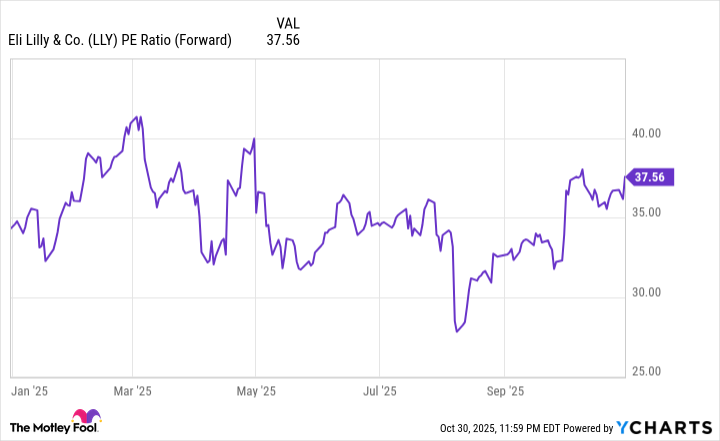Eli Lilly (LLY 1.51%) performed poorly for much of the year. However, the company is rebounding and has, for the most part, caught up with the S&P 500 year to date.
A solid clinical win for a promising candidate helped jolt the stock a few months ago. And just last week, the company's latest quarterly update provided yet another boost. Here is why Eli Lilly is a strong buy following its blowout third-quarter earnings.

Image source: Getty Images.
Eli Lilly tops lofty expectations
The market had high expectations for Eli Lilly going into its quarterly update, as it has for a while. Eli Lilly's forward price-to-earnings ratio has been much higher than that of its similarly sized competitor and the healthcare industry average, which is currently 17.1.
Even slightly above-average results would have elicited little more than a chorus of shrugs from Wall Street. But Eli Lilly did better than that. The company's revenue came in at $17.6 billion, 54% higher than the year-ago period -- an outrageous top-line growth rate for a pharmaceutical giant. Eli Lilly is increasing its sales at a rate we'd expect from a much smaller tech company. On the bottom line, Eli Lilly's non-GAAP (generally accepted accounting principles) earnings per share were $7.02, 495% higher than the prior-year quarter.
To no one's surprise, Eli Lilly's tirzepatide, sold under the brand names Mounjaro and Zepbound, drove this performance. Tirzepatide's total revenue in the quarter came in at $10.1 billion, more than doubling compared to Q3 2024. There was plenty more to like about Eli Lilly's quarterly update. The company now expects revenue of $63 billion to $63.5 billion for the fiscal year 2025, up from its previous projection of $60 billion to $62 billion. Eli Lilly's new guidance implies year-over-year revenue growth of 40.6% at the midpoint.
Why there is plenty of upside left
Eli Lilly's financial results are already fantastic, but the stock looks even more attractive when looking at ongoing developments. Here are three.
First, the company is looking to cement its dominance in the rapidly growing weight management market. After posting successful phase 3 clinical trials for its investigational oral GLP-1 candidate, orforglipron, this year, Eli Lilly is racing toward approval for the medicine, literally. The company is benefiting from a new voucher program in the U.S. that allows the Food and Drug Administration to approve a new drug in a couple of months, rather than the usual 10 months.
Eli Lilly is ready to launch orforglipron, which could now get the nod by early next year. Given that it is easier and cheaper to manufacture oral pills versus subcutaneous injections, orforglipron, which should be one of the first oral GLP-1 approved for weight loss, will help increase patient access to these highly effective medicines.

NYSE: LLY
Key Data Points
The company's other candidates in weight management include retatrutide, a drug that mimics a trio of gut hormones, one more than the already highly effective tirzepatide. Retatrutide could be yet another breakthrough. As Daniel Skovronsky, the company's chief scientific officer, said during the third quarter earnings conference call: "With its first-of-a-kind triple-acting mechanism, we expect retatrutide can deliver deeper and more rapid weight loss than existing obesity medicines. Even more than tirzepatide."
In short, Eli Lilly's work in weight management makes the stock's outlook very attractive. True, the company recently struck a deal with the White House that will force it to significantly lower the prices of Mounjaro and Zepbound, but even that shouldn't have too much of a negative impact on its financial results. These lower prices only apply to Medicare and Medicaid patients. In fact, not all those who benefit from these programs will be eligible -- only those who meet certain conditions (such as having a body mass index above a certain threshold).
Also, considering Mounjaro and Zepbound have been hard for many patients to get their hands on because they are typically very expensive without insurance coverage, the increased sales volume might somewhat offset the lower prices. So, this news isn't a significant blow to Eli Lilly's anti-obesity empire, which should continue to drive solid sales growth for the foreseeable future.
Second, the company is still producing encouraging progress in other areas, notably oncology. In the third quarter, Eli Lilly's breast cancer medicine, Verzenio, generated sales of $1.5 billion, 7% higher than the year-ago period. And in September, the company earned approval for Inluriyo, a brand-new breast cancer therapy in the U.S.
Eli Lilly has an attractive pipeline, and over the past couple of years, it has expanded it partly through acquisitions. It boasts candidates in areas beyond oncology, such as acute pain. Third, Eli Lilly is looking to stay ahead of technological changes. The company is partnering with Nvidia to build the largest artificial intelligence (AI) supercomputer in the pharmaceutical industry, which is currently owned by Recursion Pharmaceuticals, another Nvidia partner.
With this initiative, Eli Lilly aims to improve the long, slow drug development process through AI-based models. This could help speed up the task and help the company cut costs, thereby boosting its bottom line in the long run. This effort shows Eli Lilly is planning many years ahead. And given the rest of the company's business, the stock looks far too attractive to pass up, even at current levels. Eli Lilly remains a strong buy after its post-earnings jump.
